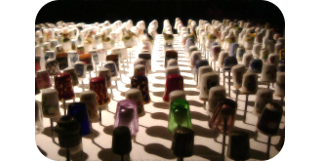A word keramikos comes from Greek and it means clay or fired clay.
κεραμικος (keramikos)
κεραμος (keramos) = soil, clay
κεραμος (keramos) = soil, clay
The ceramics is both a field of art and a science devoted to manufacturing items from inorganic, non-metallic materials by the action of heat on them (sintering or roasting). These materials may have crystal structure or may be made of glass. Products are formed usually from the liquid mass which hardens under the influence of cooling or already formed products 'ripen' by the action of the high temperature.
After forming a desired shapes and dried the mass, items are being fired once or repeatedly. Various types of furnaces are used to do that. Depending on the type of technology these are: tunnel, ventricular, graphite, etc.
The temperature of burning is from 900 to 2000°C. During the termal tratment water is removed and desired density of material is obtained. Finally, the ceramic surface can be covered with enamel.
Ceramics can be defined as any inorganic, crystalline oxides. They are solid and inert. Ceramic materials are brittle, hard, resistant to compression and easy processing.
Traditional raw materials used in the manufacture of ceramics are types of clay such as kaolinite, newer materials contain inter alia aluminium oxide (alumina). Modern substances for the manufacture of ceramic products are classified as 'advanced' and these contain inter alia silicon carbide or tungsten carbide. Both these compounds are valuable because of the abrasion. Because of it they are usually used to the manufacture of spray equipment used in mining for grinding. Such a 'advanced ceramics' is applicable also in medicine and electrical and electronic industries. Because of their properties, ceramics are often used in locations exposed to weather or corrosive substances.
The basic methods of making ceramics are: pasting, casting, turning on the wheel, turning and compacting semi-arid masses.
Products can be decorated by: enamel or glaze cover, manual or mechanical painting, printing, gilding, embossing, affixing ornaments, use the stylus.
After forming a desired shapes and dried the mass, items are being fired once or repeatedly. Various types of furnaces are used to do that. Depending on the type of technology these are: tunnel, ventricular, graphite, etc.
The temperature of burning is from 900 to 2000°C. During the termal tratment water is removed and desired density of material is obtained. Finally, the ceramic surface can be covered with enamel.
Ceramics can be defined as any inorganic, crystalline oxides. They are solid and inert. Ceramic materials are brittle, hard, resistant to compression and easy processing.
Traditional raw materials used in the manufacture of ceramics are types of clay such as kaolinite, newer materials contain inter alia aluminium oxide (alumina). Modern substances for the manufacture of ceramic products are classified as 'advanced' and these contain inter alia silicon carbide or tungsten carbide. Both these compounds are valuable because of the abrasion. Because of it they are usually used to the manufacture of spray equipment used in mining for grinding. Such a 'advanced ceramics' is applicable also in medicine and electrical and electronic industries. Because of their properties, ceramics are often used in locations exposed to weather or corrosive substances.
Artistic ceramics took roots in Europe in the XV century. Mass production has been started in the XIX century when technological processes were improved. In the XX century the most prominent artists have used the possibility of artistic ceramics. One of them was Pablo Picasso.
The basic methods of making ceramics are: pasting, casting, turning on the wheel, turning and compacting semi-arid masses.
Products can be decorated by: enamel or glaze cover, manual or mechanical painting, printing, gilding, embossing, affixing ornaments, use the stylus.
Depending on used materials we identify such products: pottery, earthenware goods, stoneware, porcelain.
Below you can see photos of ceramics thimbles from my collection (ceramics thimble Bolesławiec spots, Bolesławiec - Poland, ceramics thimble Bolesławiec yellow and forget-me-nots, Bolesławiec - Poland, ceramics thimble Bolesławiec in peas, Bolesławiec - Poland).
Writing this article I used information and pictures found at: ceramics' studio Berkanan, ceramika site, Tajga photos, Mocoloco, Putnam Arts Council, Polish Wikipedia and English Wikipedia.
* * *
Pictures of thimbles used in this article are my property.
I kindly ask for not using my articles and photos without permission.
If you have any questions, just write me.

















































































